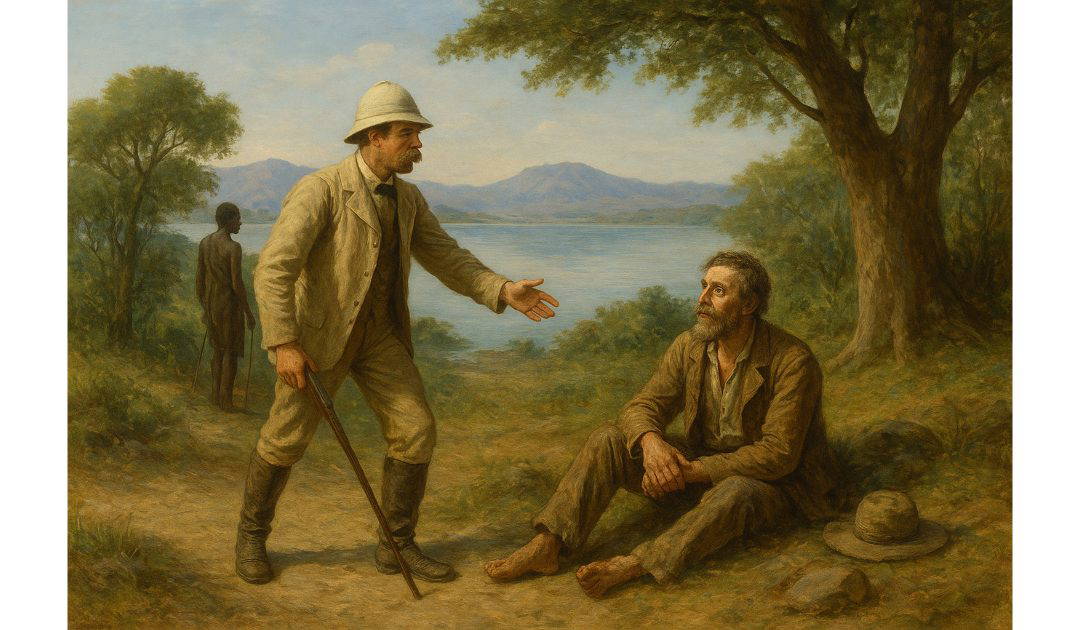On the 10th of November, 1871, Henry Morton Stanley found the missing explorer and missionary, David Livingstone in Ujiji close to Lake Tanganyika. This encounter symbolised the meeting of two worlds: the driven, resourceful journalist and adventurer sent on a mission by the modern press, and the ageing, ailing missionary and explorer whose whereabouts had become a matter of international speculation.
David Livingstone, a Scottish missionary and explorer, had devoted much of his adult life to travelling through Africa, mapping its rivers and territories, and campaigning against the slave trade. By the mid-1860s, he had become a celebrated figure in Britain, admired for both his courage and his dedication to humanitarian causes. In 1866, Livingstone embarked on what would become his final and most ambitious expedition: an attempt to locate the sources of the Nile and further document the geography of Central Africa. Over the following years, however, communication with him ceased. Rumours of his death circulated, and the British public grew increasingly concerned for his fate.
Across the Atlantic, the American newspaper the New York Herald, under the direction of its flamboyant editor James Gordon Bennett Jr., saw an opportunity. He commissioned the young correspondent Henry Morton Stanley to locate Livingstone, no matter how remote his location. Stanley, born in Wales and later naturalised as an American, was known for his persistence and his willingness to undertake arduous journeys. In 1870, he accepted the challenge and began to prepare for a daunting expedition into the largely uncharted interior of Africa.
Stanley’s undertaking was monumental. He travelled first to Zanzibar, the main port for expeditions into East Africa, where he assembled a caravan of porters, guides, and supplies. His journey into the interior was fraught with difficulties. The terrain was treacherous, the climate unforgiving, and disease an ever-present threat. He had to navigate hostile encounters, uncertain local politics, and the immense logistical challenge of moving men and goods through the African wilderness.
After months of travel, during which he followed leads and gathered reports from traders and local communities, Stanley reached the town of Ujiji in October 1871. There, on the shores of Lake Tanganyika, he finally came face to face with the man he had risked so much to find. The moment has been immortalised by the famous, if perhaps apocryphal, greeting: “Doctor Livingstone, I presume?” According to Stanley’s own account, he approached the white-bearded missionary in a composed manner, conscious of the dignity expected in such a historic moment. Livingstone, frail but alive, welcomed him warmly.
The meeting was more than a mere curiosity; it carried symbolic weight for the Victorian public. Stanley had accomplished what many thought impossible, and Livingstone, long silent in the interior of Africa, was suddenly given new life in the public imagination. The two men spent some time together in Ujiji and along the shores of Lake Tanganyika. Stanley helped to nurse Livingstone back to health and supplied him with much-needed provisions. He also gathered extensive geographical and ethnographic information, which he later sent back to his newspaper in dramatic reports.
Despite Stanley’s encouragement, Livingstone refused to abandon his mission. He was determined to continue his exploration of the waterways and to pursue his anti-slavery efforts. Stanley eventually returned to the coast and then to Europe, where he was feted as a hero and his meeting with Livingstone became the stuff of legend. Livingstone, meanwhile, pressed on with his work, but his health continued to decline. He died in 1873 in what is now Zambia, leaving behind a legacy as both a pioneering explorer and a passionate humanitarian.

